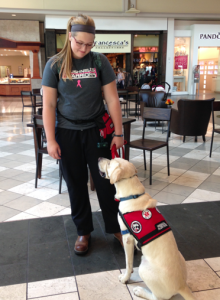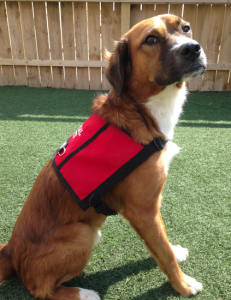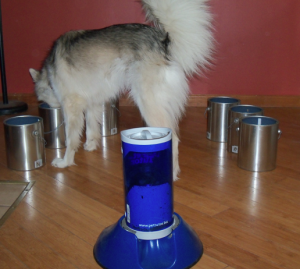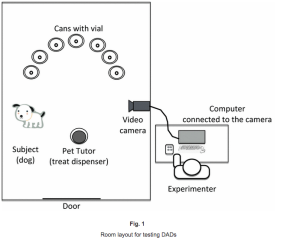 People are familiar with service dogs and there is general awe regarding a dog’s ability to help humans. Diabetes Alert Dogs (DADs) have become very popular over the past few years and there has been much press regarding their ability to help people with diabetes. However, it’s one thing to hear people talk about what DADs can do, but it’s another to actually prove their ability. Dr. Dana Hardin, a Pediatric Endocrinologist, Wes Anderson, a statistician and Smart Animal Training Systems’ founder, and myself, owner of a service dog company, have been working together on a research project aimed at showing that there is indeed a smell associated with hypoglycemia and that dogs are capable of detecting it. We have been working on this research for a few years now and we’re happy to finally be able to share our results which have been published in Diabetes Therapy. We hope that validating the ability of dogs to smell the difference between low and normal blood sugar samples from people with diabetes will help diabetics to get funding for the dogs. Most of all, it’s the first step in developing standardized methods and procedures in a field where we know so little and where there is so much that we cannot control. This article will first provide background on diabetes and then results from our new study that examined DAD accuracy in detecting low blood sugar scent samples.
People are familiar with service dogs and there is general awe regarding a dog’s ability to help humans. Diabetes Alert Dogs (DADs) have become very popular over the past few years and there has been much press regarding their ability to help people with diabetes. However, it’s one thing to hear people talk about what DADs can do, but it’s another to actually prove their ability. Dr. Dana Hardin, a Pediatric Endocrinologist, Wes Anderson, a statistician and Smart Animal Training Systems’ founder, and myself, owner of a service dog company, have been working together on a research project aimed at showing that there is indeed a smell associated with hypoglycemia and that dogs are capable of detecting it. We have been working on this research for a few years now and we’re happy to finally be able to share our results which have been published in Diabetes Therapy. We hope that validating the ability of dogs to smell the difference between low and normal blood sugar samples from people with diabetes will help diabetics to get funding for the dogs. Most of all, it’s the first step in developing standardized methods and procedures in a field where we know so little and where there is so much that we cannot control. This article will first provide background on diabetes and then results from our new study that examined DAD accuracy in detecting low blood sugar scent samples.
Background
Diabetes is a condition so common that we tend to believe that we know all about it. In fact, diabetes is a growing worldwide epidemic. Yet, most of us have no idea what patients with Type 1 diabetes go through on a daily basis. Type 1 diabetes, also known as juvenile diabetes, is an autoimmune disorder that destroys the insulin-producing cells in the pancreas. Insulin is the hormone that helps our cells take in glucose from the food we eat. Our bodies need glucose to function, so without insulin, the glucose builds up in our blood and never gets to our cells, causing them to starve. High levels of glucose in our bloodstream can over time damage the nerves and small blood vessels in our eyes, kidneys and heart, leading to blindness and other major health issues. There is no cure for type 1 diabetes, only management through diet, exercise and most of all with the injection of insulin. But injecting insulin isn’t an exact science and the need for insulin constantly changes depending on what we eat and how much we exercise. That is why hypoglycemia (low blood sugar) is the number one side effect of insulin.
During the first few years after the diagnosis of type 1 diabetes, the patients are able to feel when their glucose levels fall under normal ranges. They get sweaty, dizzy, lightheaded and sometimes confused. But as time goes by, the body gets desensitized to the symptoms and patients may not feel anything until they’re dangerously low. With very little sugar in their blood, they risk passing out, having seizures and even dying. Patients with Type 1 diabetes live in a constant fear of these sudden drops. Going to sleep at night is difficult as they cannot be sure they’ll wake up in the morning. Parents get up multiple times during the night to check on their children. Husbands and wives live in constant worry about their spouse. And let’s not forget the many who live alone, with no one to make sure they haven’t passed out. Type 1 Diabetes is a difficult and scary condition.
Technology continues to make progress. Patients have access to glucometers and continuous glucose monitors to help them manage their glucose levels. Yet, even with such devices, when the patient is distracted, very active or asleep, a hypoglycemic episode may still go undetected until the sugar levels are very low.
Many pet dogs seem to react to the changes in their owner’s glucose levels. A 2008 study (Wells & al.) showed that over 1/3 of dogs living with a diabetic will vocalize, lick their owner, jump on them, stare at them or show signs of fear like shaking or running away from their owner during a hypoglycemic event. This suggests that dogs are picking up information that is somehow meaningful to them and causes them to show signs of anxiety. Is it a stress reaction from our body? The ability to detect when a body goes into distress could have an adaptive value to canines, since it may help pick out which animals have a weakened condition within a group; we just do not know what is it that they’re reacting to?
 Through trial and error, trainers have been able to figure out that what triggers such reactions in the dogs, is smell. What smell, we don’t really know. It could be a specific organic compound excreted by the body, or a cluster of compounds. Some are convinced that the smell is related to the release of ketones. Ketones are produced when the body does not have enough insulin, and can be detected as a fruity odor on the breath. However, DADs react to low blood sugar; which may actually mean too much insulin. Thus the question remains, what are they smelling? Even without knowing what smell DADs are picking up, the fact that there is a smell related to the condition, allows us to train dogs to alert to those low blood sugar events.
Through trial and error, trainers have been able to figure out that what triggers such reactions in the dogs, is smell. What smell, we don’t really know. It could be a specific organic compound excreted by the body, or a cluster of compounds. Some are convinced that the smell is related to the release of ketones. Ketones are produced when the body does not have enough insulin, and can be detected as a fruity odor on the breath. However, DADs react to low blood sugar; which may actually mean too much insulin. Thus the question remains, what are they smelling? Even without knowing what smell DADs are picking up, the fact that there is a smell related to the condition, allows us to train dogs to alert to those low blood sugar events.
What does a DAD do?
Let’s be clear. A Diabetes Alert Dog should not replace existing medical devices. However, a DAD provides an extra layer of security with a few extras. When they detect the specific smell they have been conditioned to identify, they alert their person that it’s time to check their glucose levels. But unlike any other monitoring devices, DADs can also wake up the person, get help, get a phone or bring glucose tablets or a juice if their person is too weak to get up. They can help with balance or getting up after a fall, etc.
Training a DAD isn’t easy however. Trainers with all sorts of backgrounds are now training such dogs with different levels of success. Some have lots of experience with scent training in other fields, but none working with service dogs. For example some trainers have worked in search and rescue, or in training narcotics detection dogs; however, that expertise does not necessarily translate to the training of a medical detection dog. There are similarities of course, but there are also major differences due to the nature of the scent. For instance, if a person has a hypoglycemic episode at 9:00am and is back within normal range at 10:00am, that person will still carry the smell on her skin and clothes. That residual scent will be stronger than the sample we might have used during training. There are also times when the dog gives an alert, but the glucose monitor indicates that the person is within normal range. Is it a false positive, or is the dog sensing the start of the drop in glucose levels? Is the monitor giving an accurate reading? Without the olfactory ability of dogs, trainers are often left with only their best guess.
Over the years, we have witnessed so many problems in this particular field. Trainers seem to come up with their own way to train DADs. Some dogs are placed too young, and others alert, but don’t behave well in public. Some dogs are trained to alert in ways which is problematic when in public (like barking); others don’t alert reliably, etc. There are trainers who claim that if you love the dog enough, the dog will alert! Others promise that you should touch your dog’s nose several times during the day. “When it feels cold, it’s the dog’s way of telling you to test your glucose levels” (and I’m not making this up!!). Fortunately there are also plenty of great trainers who fully understand the responsibility that they carry in the dogs they place. But like in any new field of work, there is an urgent need for standardized procedures of training and for criteria (for more information about what to look for in a DAD, read “Diabetes Alert Dogs: Buyer Beware“). When someone’s life is in the balance, it’s just not enough to say we can do it we have to be able to prove it and we have to constantly test our procedures in order to improve our results.
The Study: Are DADs accurate?
The goal of our study was to show that dogs distinguish Low blood glucose scent samples from Normal blood glucose scent samples (Hardin & al., 2015). We hypothesized that we could demonstrate that there is indeed a scent associated with a drop in glucose levels and that dogs could be trained to alert to the presence of that smell. We believed that once that’s established, we could expand our research and work towards identifying the organic compounds that are present in the samples. We also want to establish the best way to collect samples (skin swab, saliva or breath) and determine optimal ways to keep the samples. Science allows us to be as objective as possible about what dogs can or cannot do and help us improve the way that we train DADs.
For the purpose of the study, 6 dogs were trained to identify the Low sample (under 70 mg/dl) amongst 7 samples that were presented. Two of the samples were Normal (between 80-130 mg/dl) and from the same person as the Low sample, and the 4 others were blank. The samples consisted of gauze pads that had been wiped on the forehead and back of the neck of a person with Type 1 diabetes then placed in a zip locked bag. The patients were instructed to blow into the bag before sealing it, adding breath to the sample. The samples were placed in glass vials, then in gallon size metal paint buckets. Each bucket contained a vial with a gauze pad, making them all visually identical. The 7 buckets were placed in a semi-circle in front of the dog (see figure 1).
To make sure that the dog could only rely on scent to find the sample, and prevent and potential information from the handler, we decided to use an automatic treat dispenser, the Pet Tutor®, to reward the dog. The dog was led into the test room and the handler stayed outside of the room while the dog searched for the Low sample. The dog’s behavior was monitored and recorded with a video camera. The results of the study confirm that the dogs are indeed able to detect and be trained and to alert to hypoglycemic samples. The DADs were able to find the Low samples based on smell alone. (Click here for the full study).
This study is a first step in understanding how dogs can be effective assistants in monitoring diabetes. Discrimination training is only a step in the training of DADs, there are many more steps needed before and after placing a dog with a patient to help the DAD transition from samples to live events. This is not a measure of accuracy of the dogs once they’re placed with a person, as many variables can affect their perception and their behavior but provides us with a foundation that we can now build upon.
Dogs have been recognized for their ability to assist humans in all sorts of tasks with their keen sense of smell. Medical detection has been a growing field of interest in the past few years, and dogs are now used to detect cancer, to alert to seizures and of course to drops in glucose levels. Studying what it is that the dog’s nose detects, can expand our ability to understand and treat certain medical conditions. When it comes to diabetes, dogs have shown us how much difference they can make in the life of a patient. It’s up to us to come together and develop better standards in the industry. Finally, the very first Diabetes Alert Dog conference and workshop will open its doors in WV in November 2015, a first step towards standardization and open conversation about the training of DADs between trainers.




Thank you Jennifer, this study is really important! We need to open new doors to help people with Diabetes.
Thank you Jennifer, I learned many thing from your post.
You can try this free dog training pdf: http://goo.gl/6E71ue
That’s awesome. My daughter is a type 1 brittle diabetic. This would be awesome for hwr. She is also a dog recuser. And has place more the 170 dogs to good families.
Would love info to get ideas of places in the US
Thank you
Medical Mutts specializes in training rescue dogs as service dogs for conditions such as diabetes, seizures, autism, etc. and places dogs nationwide: http://www.medicalmutts.com/
Thank you for this research. My daughter has had Type 1 Diabetes since she was 2 years old. She is now 21, but she was showing her horse a couple and even her horse could detect when her blood sugars were low. The horse would start pawning the ground and start dancing and fidgeting and after the first couple times he did this we realized my daughter had a low blood sugar.
This makes for some great reading.
I’d love to teach my own dogs to alert on high (or low) BG levles.
Thanks so much for sharing
Miami Dog Training